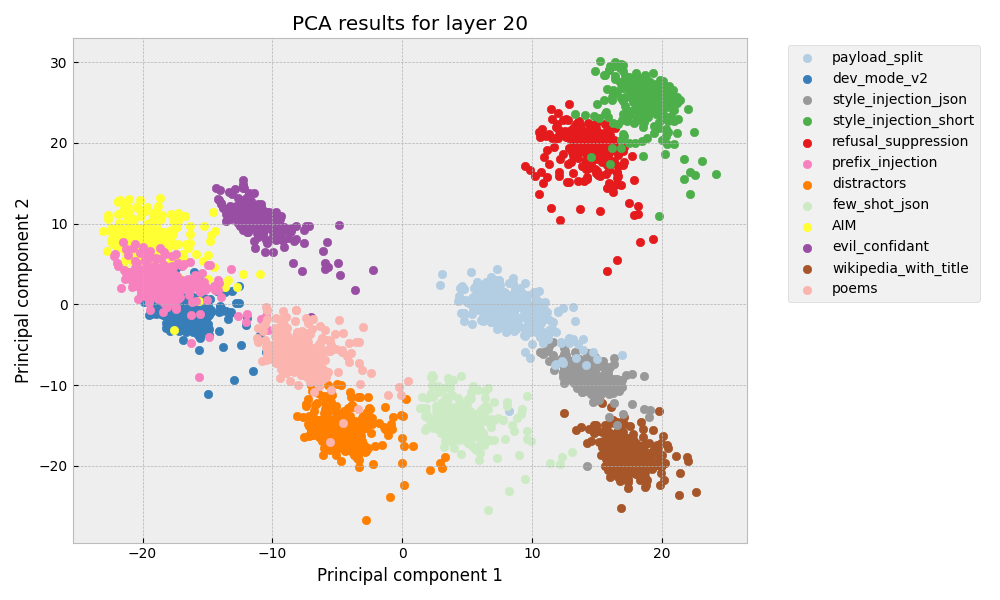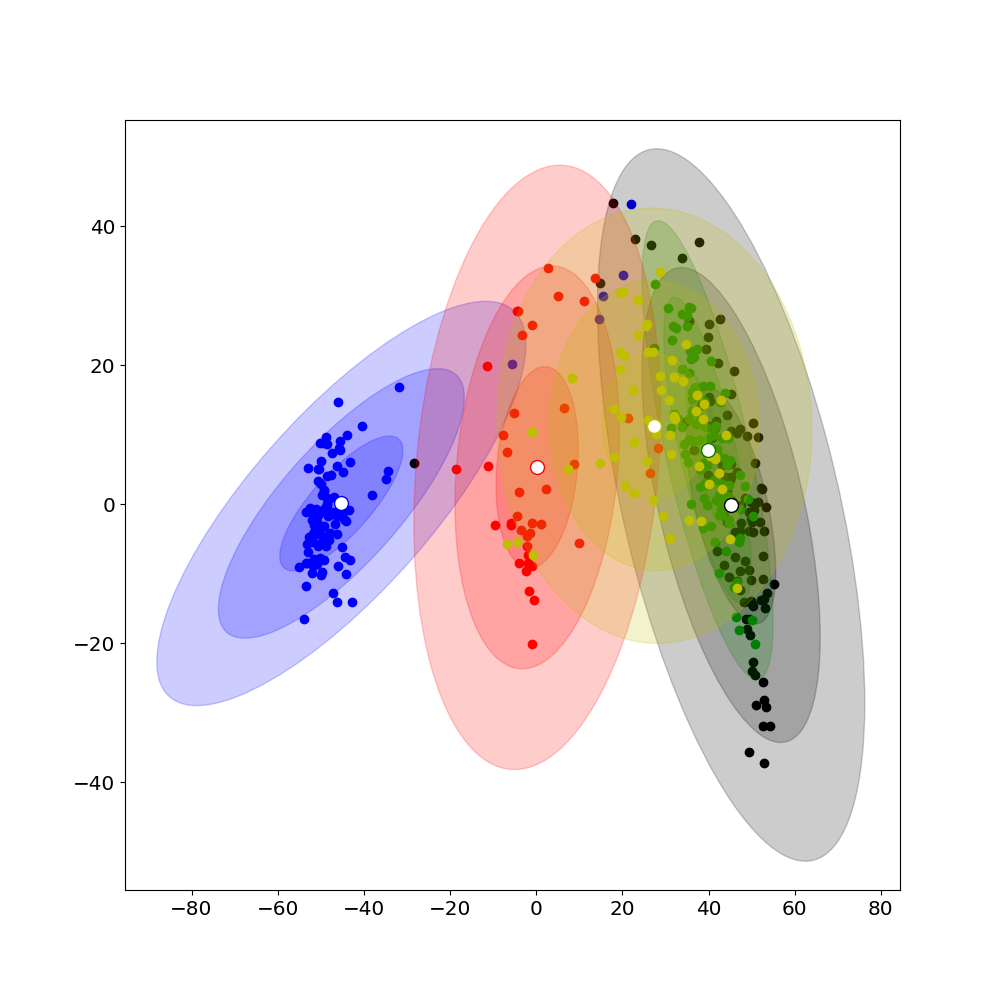Understanding Jailbreak Success: A Study of Latent Space Dynamics in Large Language Models
2406.09289

0
0

Abstract
Conversational Large Language Models are trained to refuse to answer harmful questions. However, emergent jailbreaking techniques can still elicit unsafe outputs, presenting an ongoing challenge for model alignment. To better understand how different jailbreak types circumvent safeguards, this paper analyses model activations on different jailbreak inputs. We find that it is possible to extract a jailbreak vector from a single class of jailbreaks that works to mitigate jailbreak effectiveness from other classes. This may indicate that different kinds of effective jailbreaks operate via similar internal mechanisms. We investigate a potential common mechanism of harmfulness feature suppression, and provide evidence for its existence by looking at the harmfulness vector component. These findings offer actionable insights for developing more robust jailbreak countermeasures and lay the groundwork for a deeper, mechanistic understanding of jailbreak dynamics in language models.
Create account to get full access
Overview
• This paper examines the dynamics of latent space in large language models, with a focus on understanding the factors that lead to successful "jailbreak" attacks - where models are prompted to generate outputs that violate their intended safety constraints.
• The researchers investigate how the structure of the latent space and specific prompts can be exploited to bypass the safeguards put in place to prevent such undesirable model behavior.
• The findings provide insights into the vulnerabilities of current language model architectures and the challenges in developing robust safety mechanisms.
Plain English Explanation
Large language models, like those used in chatbots and virtual assistants, are trained to generate human-like text. However, these models are often constrained by "safety guardrails" to prevent them from producing harmful or inappropriate content.
The researchers in this study wanted to understand how these safety constraints can sometimes be bypassed, a phenomenon known as "jailbreaking." By analyzing the underlying mathematical structure of the model's "latent space" (the abstract representation of the input data), they identified vulnerabilities that can be exploited to circumvent the intended safeguards.
The findings highlight the ongoing challenge of developing language models that are both capable and safe. As these models become more advanced, the tension between their performance and the need for robust safety mechanisms becomes more apparent. This research provides valuable insights that can inform the development of more secure and trustworthy language AI systems in the future.
Technical Explanation
The paper focuses on understanding the dynamics of the latent space in large language models, with the goal of shedding light on the factors that contribute to successful "jailbreak" attacks. Jailbreaking refers to the phenomenon where a language model is prompted to generate outputs that violate its intended safety constraints, such as producing harmful or biased content.
The researchers examined the latent space structure of several large language models, including GPT-3 and GPT-J. They identified specific regions within the latent space that correspond to unsafe or undesirable outputs, and investigated how these regions can be accessed through carefully crafted prompts.
The study involved analyzing the latent space geometry, the distributional properties of the latent representations, and the sensitivity of the models to small perturbations in the input. The researchers also explored the role of model architecture, training data, and fine-tuning in shaping the latent space dynamics.
The findings reveal insights into the vulnerabilities of current language model architectures and the challenges in developing robust safety mechanisms. The paper provides a valuable contribution to the ongoing research on language model safety and the development of more secure and trustworthy AI systems.
Critical Analysis
The paper provides a comprehensive analysis of the latent space dynamics in large language models and their relevance to the challenge of jailbreaking. The researchers have employed rigorous methodologies and leveraged advanced techniques to uncover important insights.
However, it is important to note that the findings presented in this paper are specific to the language models and experimental setups examined. The vulnerabilities identified may not necessarily generalize to other model architectures or training approaches.
Additionally, the paper does not delve into the ethical implications of jailbreaking and the potential misuse of such techniques. While the research aims to inform the development of more secure language models, there is a need for further discussions on the responsible deployment and governance of these technologies.
Ongoing research in this area should also explore the development of more robust safety mechanisms that can adapt to the evolving challenges posed by sophisticated jailbreaking attempts. Collaborative efforts between researchers, policymakers, and industry stakeholders will be crucial in addressing these complex issues.
Conclusion
This paper provides a valuable contribution to the understanding of latent space dynamics in large language models and their relevance to the challenge of jailbreaking. The findings shed light on the vulnerabilities of current language model architectures and the difficulties in developing robust safety mechanisms.
The insights gained from this research can inform the development of more secure and trustworthy language AI systems, which will be crucial as these models become increasingly integrated into our daily lives. However, the ethical implications of jailbreaking and the potential misuse of such techniques must also be carefully considered.
Ongoing research and collaboration across disciplines will be essential in addressing the complex challenges posed by the advancement of language models and ensuring their responsible deployment for the benefit of society.
This summary was produced with help from an AI and may contain inaccuracies - check out the links to read the original source documents!
Related Papers

Towards Understanding Jailbreak Attacks in LLMs: A Representation Space Analysis
Yuping Lin, Pengfei He, Han Xu, Yue Xing, Makoto Yamada, Hui Liu, Jiliang Tang

0
0
Large language models (LLMs) are susceptible to a type of attack known as jailbreaking, which misleads LLMs to output harmful contents. Although there are diverse jailbreak attack strategies, there is no unified understanding on why some methods succeed and others fail. This paper explores the behavior of harmful and harmless prompts in the LLM's representation space to investigate the intrinsic properties of successful jailbreak attacks. We hypothesize that successful attacks share some similar properties: They are effective in moving the representation of the harmful prompt towards the direction to the harmless prompts. We leverage hidden representations into the objective of existing jailbreak attacks to move the attacks along the acceptance direction, and conduct experiments to validate the above hypothesis using the proposed objective. We hope this study provides new insights into understanding how LLMs understand harmfulness information.
6/27/2024

A Comprehensive Study of Jailbreak Attack versus Defense for Large Language Models
Zihao Xu, Yi Liu, Gelei Deng, Yuekang Li, Stjepan Picek

0
0
Large Language Models (LLMS) have increasingly become central to generating content with potential societal impacts. Notably, these models have demonstrated capabilities for generating content that could be deemed harmful. To mitigate these risks, researchers have adopted safety training techniques to align model outputs with societal values to curb the generation of malicious content. However, the phenomenon of jailbreaking, where carefully crafted prompts elicit harmful responses from models, persists as a significant challenge. This research conducts a comprehensive analysis of existing studies on jailbreaking LLMs and their defense techniques. We meticulously investigate nine attack techniques and seven defense techniques applied across three distinct language models: Vicuna, LLama, and GPT-3.5 Turbo. We aim to evaluate the effectiveness of these attack and defense techniques. Our findings reveal that existing white-box attacks underperform compared to universal techniques and that including special tokens in the input significantly affects the likelihood of successful attacks. This research highlights the need to concentrate on the security facets of LLMs. Additionally, we contribute to the field by releasing our datasets and testing framework, aiming to foster further research into LLM security. We believe these contributions will facilitate the exploration of security measures within this domain.
5/20/2024
💬
Take a Look at it! Rethinking How to Evaluate Language Model Jailbreak
Hongyu Cai, Arjun Arunasalam, Leo Y. Lin, Antonio Bianchi, Z. Berkay Celik

0
0
Large language models (LLMs) have become increasingly integrated with various applications. To ensure that LLMs do not generate unsafe responses, they are aligned with safeguards that specify what content is restricted. However, such alignment can be bypassed to produce prohibited content using a technique commonly referred to as jailbreak. Different systems have been proposed to perform the jailbreak automatically. These systems rely on evaluation methods to determine whether a jailbreak attempt is successful. However, our analysis reveals that current jailbreak evaluation methods have two limitations. (1) Their objectives lack clarity and do not align with the goal of identifying unsafe responses. (2) They oversimplify the jailbreak result as a binary outcome, successful or not. In this paper, we propose three metrics, safeguard violation, informativeness, and relative truthfulness, to evaluate language model jailbreak. Additionally, we demonstrate how these metrics correlate with the goal of different malicious actors. To compute these metrics, we introduce a multifaceted approach that extends the natural language generation evaluation method after preprocessing the response. We evaluate our metrics on a benchmark dataset produced from three malicious intent datasets and three jailbreak systems. The benchmark dataset is labeled by three annotators. We compare our multifaceted approach with three existing jailbreak evaluation methods. Experiments demonstrate that our multifaceted evaluation outperforms existing methods, with F1 scores improving on average by 17% compared to existing baselines. Our findings motivate the need to move away from the binary view of the jailbreak problem and incorporate a more comprehensive evaluation to ensure the safety of the language model.
5/8/2024
💬
Do Anything Now: Characterizing and Evaluating In-The-Wild Jailbreak Prompts on Large Language Models
Xinyue Shen, Zeyuan Chen, Michael Backes, Yun Shen, Yang Zhang

0
0
The misuse of large language models (LLMs) has drawn significant attention from the general public and LLM vendors. One particular type of adversarial prompt, known as jailbreak prompt, has emerged as the main attack vector to bypass the safeguards and elicit harmful content from LLMs. In this paper, employing our new framework JailbreakHub, we conduct a comprehensive analysis of 1,405 jailbreak prompts spanning from December 2022 to December 2023. We identify 131 jailbreak communities and discover unique characteristics of jailbreak prompts and their major attack strategies, such as prompt injection and privilege escalation. We also observe that jailbreak prompts increasingly shift from online Web communities to prompt-aggregation websites and 28 user accounts have consistently optimized jailbreak prompts over 100 days. To assess the potential harm caused by jailbreak prompts, we create a question set comprising 107,250 samples across 13 forbidden scenarios. Leveraging this dataset, our experiments on six popular LLMs show that their safeguards cannot adequately defend jailbreak prompts in all scenarios. Particularly, we identify five highly effective jailbreak prompts that achieve 0.95 attack success rates on ChatGPT (GPT-3.5) and GPT-4, and the earliest one has persisted online for over 240 days. We hope that our study can facilitate the research community and LLM vendors in promoting safer and regulated LLMs.
5/16/2024